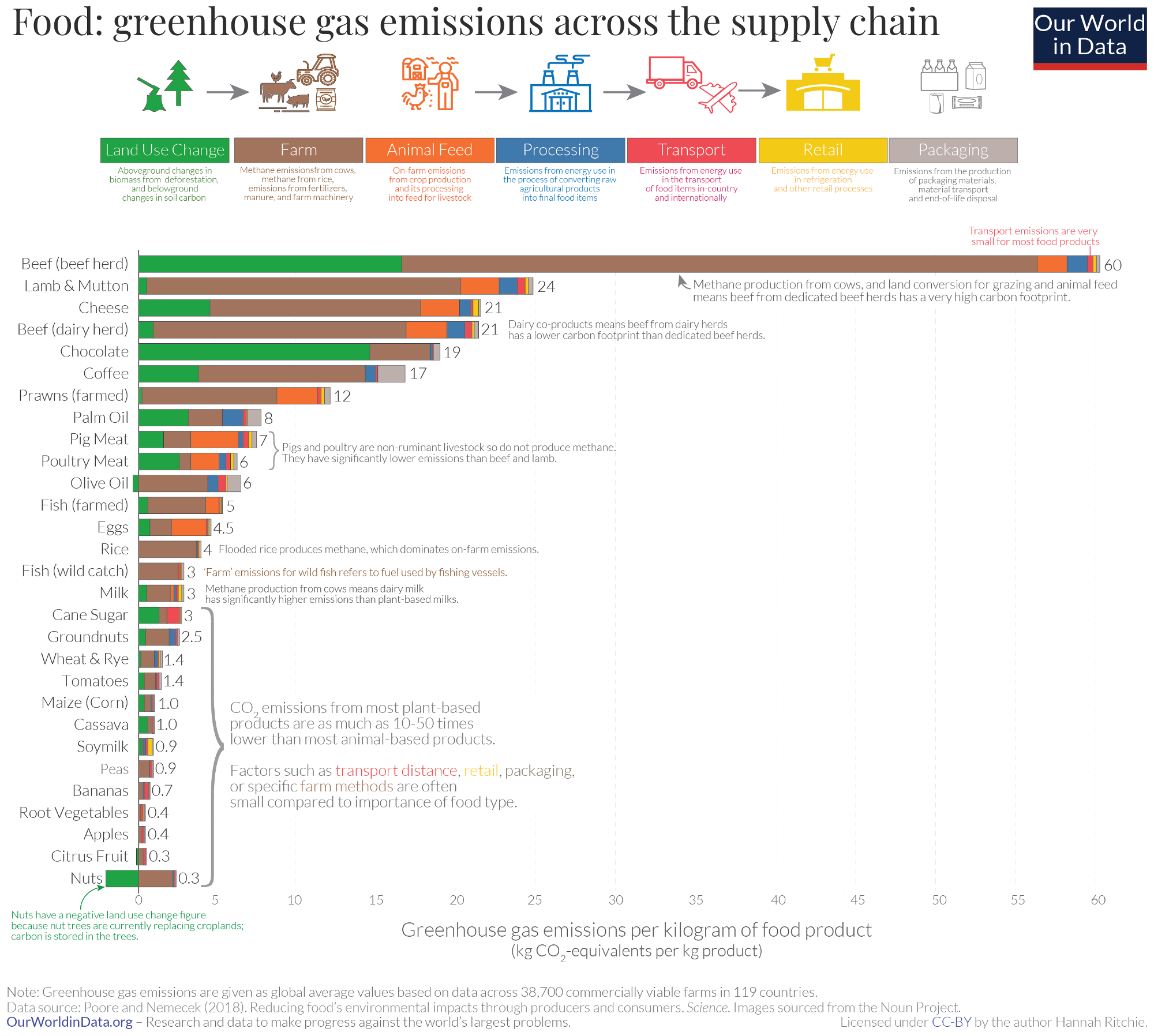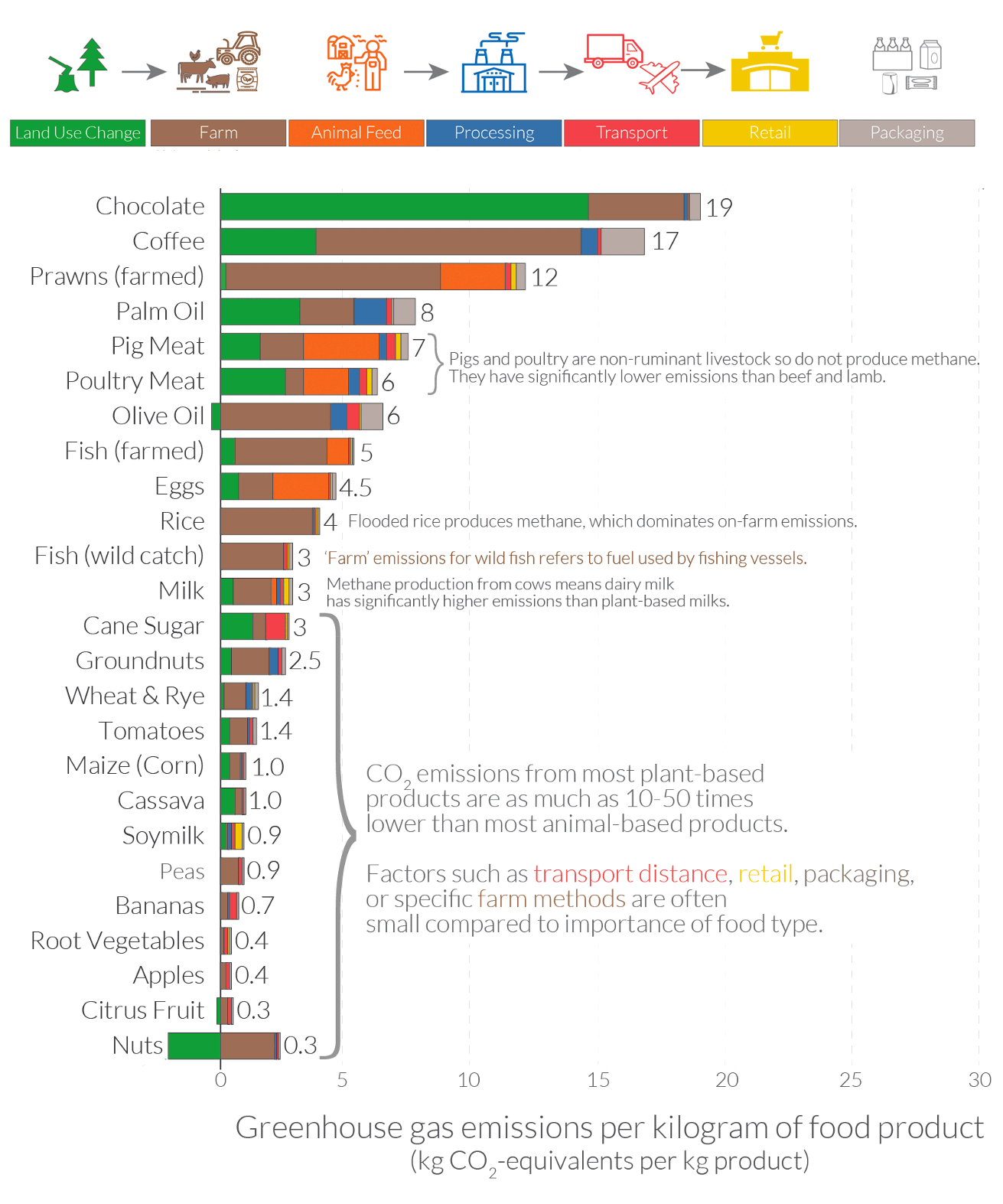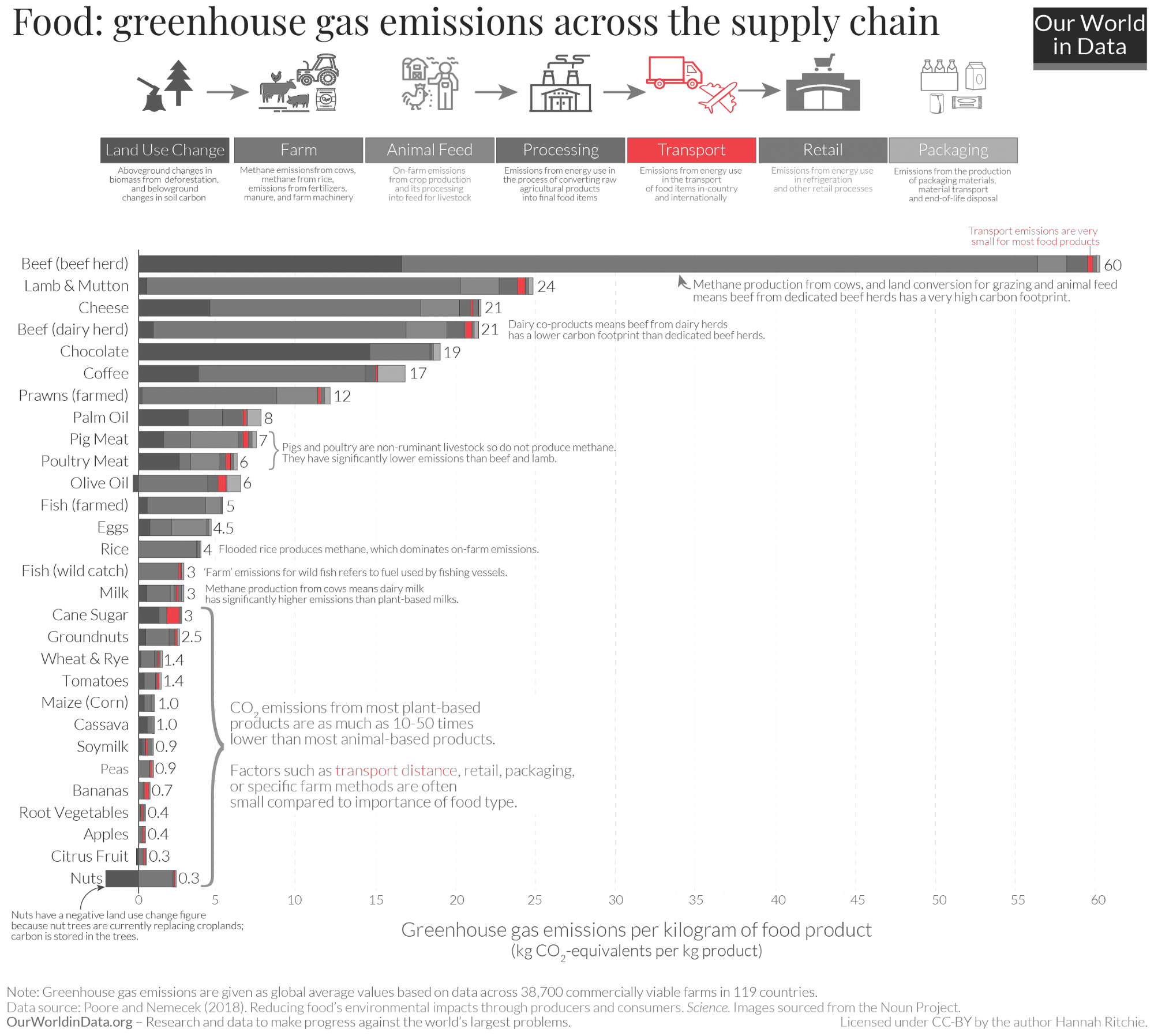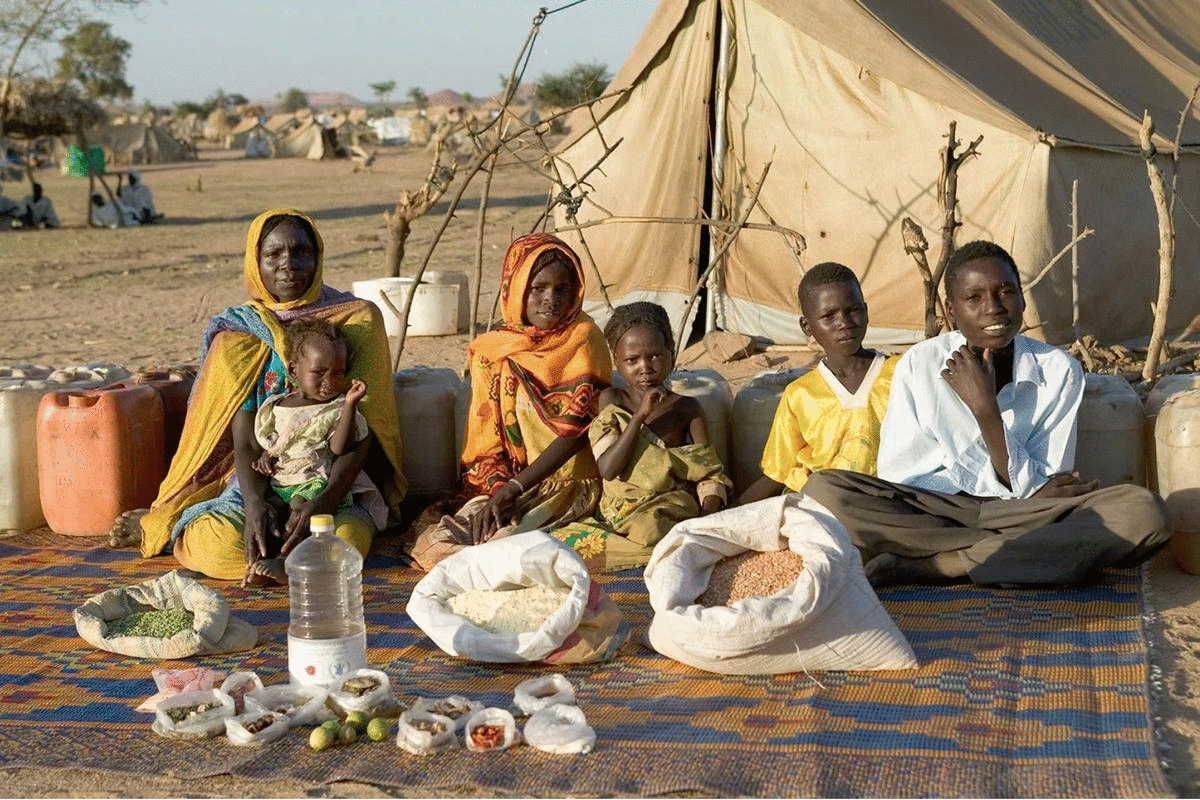What’s The Carbon Cost Of Food?
Counting carbon calories

This animation shows the different emissions for different types of food. It’s based on work from Our World In Data, which is like a calorie counter for food — from farm to plate.
These aren’t calories we put on our bellies, this is the weight we put on the Earth, and on our children. Some of us are really packing on the kilos.
Let’s have a closer look at the original graph:

There’s a lot here. Let’s break it down.
What’s the worst?

If you look at the graph, beef sticks out like a giant, sore and murderous thumb. There’s no way to moderate this. If you care, you have to consume beef as rarely as, like, escargot.
The emissions from ruminants (grass eaters) are literally off the chart. Their four stomachs are methane factories and their burps are toxic. It’s funny but it’s really not. A dedicated beef farm is an emissions factory, plain and simple, not to mention a place of misery. Kilo for kilo, beef emits 150x as much as apples. This isn’t a case of apples and oranges. It’s apples and Agent Orange.
After seeing graphs like this I quit beef completely. I never touch the stuff. The Hindus were right.
Oh God, not coffee

The second thing that stands out to me is coffee. Maybe it’s chocolate for you. A kilo of coffee emits 19kg of CO2 equivalent. I was like, ‘oh shit, I have two children, do I need to start doing Ritalin in the morning?’ but then I remembered. Per kilogram. One kilo of coffee beans is like 100 cups of coffee. I drink maybe 25 a month.
This still needs to be decarbonized, everything needs to be completely unplugged from fossil fuels, but coffee and chocolate are not as destructive as a quarter-pounder. Unless you’re drinking a ton of coffee, which I think would have destroyed your bowels by now.
What’s the best?
Let’s take beef out of the graph, it distorts the whole thing (and our climate). I’m doing this to see better, but we need to do the same thing if we want to live better. Here’s the graph without ruminants.

Now you can see that, besides specialty products, the big divide is between an animal or plant-based diet. Plant-based products emit 10–20 times less than (non-beef) animal products.
It’s interesting how health and religious and moral imperatives all intersect here, on the right thing to do. It’s as if our spirituality, our well-being, and our ethics are all connected to the Earth. Because they are.
As Peppa Pig says, fruit and vegetables keep us alive. The absolute best climate foods are nuts and legumes (like lentils). Nuts replace cropland and store carbon. Legumes return nitrogen to the soil. As a rule of thumb, however, plant-based is the way to go, the closer to vegan the better.
I’ve tried going vegan and it’s a bit hard. Pancakes aren’t vegan. Coconut sambol with dried fish isn’t vegan. Even a whiskey sour isn’t vegan. Even if you’re trying, it’s honestly easy to forget. Luckily, from an environmental perspective, going veganish is nearly good enough. You don’t have to fatwa all animal products, just do your best, on the days and meals you can.

As you can see in this graphic from The Economist, going two-thirds vegan can even be better than a dairy-heavy vegetarian.
But what about how I eat?
What about eating local, or organic? These may be good for other reasons, but not for the environment. They don’t really matter. Here’s the graph recolored to show just transport emissions.

As you can see, the transport contribution is negligible. If you eat local beef, congratulations, you’ve drawn a peace sign on a nuclear bomb. Eat an avocado from the other side of the world and you’ll still be 40x ahead. Eating local is nice for many reasons, but reducing carbon calories isn’t one of them.
The simple truth is that it’s not how you eat but what you eat.
The same for organic. This can be good for managing soils without fertilizer, but A) not enough and B) not at the scale required to feed people. None of these effects can overpower what a certain food is.
Companies love labeling all kinds of foods ‘natural’ or ‘organic’ or ‘sustainable’ but nothing can overcome the basic nature of the product. Even if a pig is raised free and only killed after using Twitter enough to say ‘kill me now’, it’s still a pig. It still uses a certain amount of land, water, and feed. A GMO banana, insulted from birth and shipped from Guatemala is still 10x better.
You are what you eat, not how it’s grown.
Who’s Responsible?

These different diets are not evenly distributed across the world. As you can see in these images from Peter Menzel, the consumption — and emissions — are drastically different for a rich American family and a poor family in Africa. It’s not just that Americans eat dramatically more, they also emit more greenhouse gases in the process.
As with carbon emissions in general, it’s the rich who are primarily responsible. The top 10% are responsible for 50% of lifestyle emissions overall. Overconsumption is the problem, not overpopulation, and this includes rich diets. Environmental destruction is just one consequence of this, these diets are also destructive to human health, and the dignity and rights of animals.
It’s rich people (and countries) causing the damage but, unfortunately, everyone tends to emulate these diets as soon as they get some money. And rich societies throw huge amounts of subsidies at certain foods, and those industries acquire political power. That’s the actual point to attack, not personal consumption.
So What?
You are what you eat, and you emit what you eat. And yet, personal responsibility is not the point. It is actually a distraction from the big, societal change we need to make. If you eat only beef and march every day to ban fossil fuels (stopping only to explosively shit yourself), you’re still a net positive to the world. The way out of climate change is not the change of any particular diet, but the change of entire political systems that subsidize this sort of eating and chain all growth to fossil fuels.
It is political action and not personal virtue that’s key to fighting climate change, and it’s very important to remember that. They’re connected, but personal change is simply not going to do it. The most urgent thing is to completely stop using fossil fuels. If you can change your government’s position on that, hell, I’ll buy you a steak. I’ll grill you my own rump.
At the same time, as we make societal changes to move us into the 21st century, a change in diet will have to be a part of that. Primarily a change in what we subsidize, but ultimately a change in what we eat. And it’s not like history has stopped. Diet has always been changing and it’s always time to change some more.
So as you think of your diet, remember that. Keep your eye on the prize, and don’t get distracted by the seeming impossibility of changing your own lifestyle, let alone everyone else’s. And then maybe, at leisure, think about your lifestyle. Because it can be a positive change, not just for the environment, but for you.
What I find most interesting is how what’s good for the environment is good for animals is good for society is good for the individual. And how the teachings of prophets and scientists and economists can all converge.
That, if anything, is the lesson climate change is trying to teach us. That we are not separate, we are not distinct, and we are not alone. We are connected to the air, to other animals, to each other and to this living planet we call home. If we take care of the Earth, we take care of ourselves, and vice versa.
You are what you eat and you emit what you eat. So if you’re counting calories, you should be counting carbon calories as well. It’s good and, honestly, it tastes good as well.